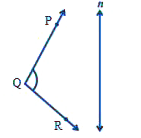Two particles p and q located at distances rp and rq respectively from the centre of a rotating disc such that rp>rq.
Both P and Q have the same acceleration
BothP and Q do not have any acceleration
P has greater acceleration than Q
Q has greater acceleration than P
The correct Answer is:C
Angular velocity and angular acceleration of every particle of disc is same
ap=rP√α2+ω2,aQ=rQ√α2+ω4
∵rP>rQ⇒aP>aQ
Topper's Solved these Questions
Similar Questions
Draw the images P' , Q' and R' of the point P, Q and R respectively in the line n (Fig . 9. 18). Join P' Q' and Q' R' to form an angle P' Q' R' Measure ∠PQRand∠P'Q'R' . Are the two angles equal ?

View SolutionTwo loops P and Q are made from a uniform wire. The radii of P and Q are R1andR2 respectively and their moments of inertia are IPandIQ respectively.
If IPIQ=8 then R1R2 is
View Solution
Knowledge Check
Two particles P and Q are located at distance rpandrQ respectively form the centre of rotating disc such that rP>rQ. The disc is rotating with constant angular acceleration. We can say
Aboth P and Q have the same accelerationBboth P and Q do not have the same accelerationCP has greater acceleration than QDQ has greater acceleration than PTwo particles P and Q are located at distance rpandrQ respectively form the centre of rotating disc such that rP>rQ. The disc is rotating with constant angular acceleration. We can say
ABoth P and Q have the same acceelerationBBoth P and Q do not have any accelcrationCP has greater acceleration than QDQ has greater acceleration than PIf p→(q∧r) is false, then the truth values of p,q and r are respectively
AT,F and FBF,F and FCF, T and TDT,T and F
If p→q(q∨r) is false, then the truth values of p,q,r are respectively
View SolutionIf the pth,qthandrth terms of an A.P. be a, b, c respectively, then
a(q−r)+b(r−p)+c(p−q)=
View SolutionThe average ages of (P,Q),(Q,R),(R,P) are 13,14 and 12 years respectively. What is the age of Q ?
View SolutionIf p,q and r are simple propositions such that (p∧q)∧(q∧r) is true, then
View SolutionIf p, q, and r are the statements and (p∧q)∧(q∧r) is true, then
View Solution